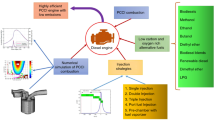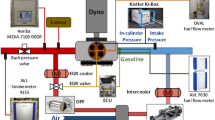Abstract
Recent studies on dual-fuel combustion in compression-ignition (CI) engines, also known as diesel engines, fall into two categories. In the first category are studies focused on the addition of small amounts of gaseous fuel to CI engines. In these studies, gaseous fuel is regarded as a secondary fuel and diesel fuel is regarded as the main fuel for combustion. The objectives of these studies typically involve reducing particulate matter (PM) emissions by using gaseous fuel as a partial substitution for diesel fuel. However, the addition of gaseous fuel raises the combustion temperature, which increases emissions of nitrogen oxides (NOx). In the second category are studies focused on reactivity-controlled compression-ignition (RCCI) combustion. RCCI combustion can be implemented by early diesel injection with a large amount of low-reactivity fuel such as gasoline or gaseous fuel. Although RCCI combustion promises lower NOx and PM emissions and higher thermal efficiency than conventional diesel combustion, it requires a higher intake pressure (usually more than 1.7 bars) to maintain a lean fuel mixture. Therefore, in this study, practical applications of dual-fuel combustion with a low air-fuel ratio (AFR), which implies a low intake pressure, were systemically evaluated using propane in a diesel engine. The characteristics of dualfuel combustion for high and low AFRs were first evaluated. The proportion of propane used for four different operating conditions was then increased to decrease emissions and to identify the optimal condition for dual-fuel combustion. Although the four operating conditions differ, the AFR was maintained at 20 (ϕ approximately equal to 0.72) and the 50% mass fraction burned (MFB 50) was also fixed. The results show that dual-fuel combustion can reduce NOx and PM emissions in comparison to conventional diesel combustion.
Similar content being viewed by others
References
Akihama, K., Takatori, Y., Inagaki, K., Sasaki, S. and Dean, A. M. (2001). Mechanism of the smokeless rich diesel combustion by reducing temperature. SAE Paper No. 2001-01-0655.
Curran, S., Prikhodko, V., Cho, K. W., Charles, S., James, P., Robert, W., Sage, K. and Reitz, R. (2010). In-cylinder fuel blending of gasoline/diesel for improved efficiency and lowest possible emissions on a multi-cylinder lightduty diesel engine. SAE Paper No. 2010-01-2206.
Hanson, R., Sage, K., Splitter, D. and Reitz, R. (2011). Fuel effects on reactivity controlled compression ignition (RCCI) combustion at low load. SAE Paper No. 2011-01-0361.
Hasegawa, R. and Yanagihara, H. (2003). HCCI combustion in DI diesel engine. SAE Paper No. 2003-01-0745.
Kamran, P., Fathollah, O., Hamed, Y. and Amin, N. (2012). An investigation on effect of high pressure post injection on soot and NO emissions in a DI diesel engine. The J. Mechanical Science and Technology, 26, 269–281.
Kim, D. S., Ekoto, I., Colban, W. F. and Miles, P. C. (2008). In-cylinder CO and UHC imaging in a light-duty diesel engine during PPCI low-temperature combustion. SAE Paper No. 2008-01-1602.
Kim, H. J. (2012). Experimental Researches for the Emission Reduction by Propane Addition on Dual Fuel Diesel Engine. M. S. Thesis. Mechanical and Aerospace Engineering of Seoul National University. Seoul. Korea.
Kimura, S., Aoki, O., Ogawa, H., Muranaka, S. and Enomoto, Y. (1999). New combustion concept for ultraclean and high-efficiency small DI diesel engines. SAE Paper No.1999-01-3681.
Koci, C. P., Ra, Y., Krieger, R., Andrie, M., Foster, D. E., Siewert, R. M., Durrett, R. P., Ekoto, I. and Miles, P. C. (2009). Detailed unburned hydrocarbon investigations in a highly-dilute diesel low temperature combustion regime. SAE Paper No. 2009-01-0928.
Kokjohn, S. and Reitz, R. (2010). Characterization of dualfuel PCCI combustion in a light-duty engine. Int. Multidimensional Engine Modeling User’s Group Meeting.
Kumar, R., Zheng, M., Asad, U. and Reader, G. T. (2007). Heat release based adaptive control to improve low temperature diesel engine combustion. SAE Paper No. 2007-01-0771.
Ladommatos, N., Abdelhalim, S. M., Zhao, H. and Hu, Z. (1997). The dilution, chemical, and thermal effects of exhaust gas recirculation on diesel engine emissions — Part 4: Effects of carbon dioxide and water vapor. SAE Paper No. 971660.
Liu, C., Karim, G. A., Xiao, F. and Sohrabi, A. (2007). An experimental and numerical investigation of the combustion characteristics of a dual fuel engine with a swirl chamber. SAE Paper No. 2007-01-0615.
Liu, Y., Yeom, J. K. and Chung, S. S. (2012). An experimental study on the effects of impingement-walls on the spray and combustion characteristics of SIDI CNG. The J. Mechanical Science and Technology, 26, 2239–2246.
Nieman, D. E., Dempsey, A. B. and Reitz, R. (2012). Heavy-duty RCCI operation using natural gas and diesel. SAE Paper No. 2012-01-0379.
Papagiannakis, R. G., Rakopoulos, C. D., Hountalas, D. T. and Rakopoulos, D. C. (2010). Emission characteristics of high speed, dual fuel, compression ignition engine operating in a wide range of natural gas/diesel fuel properties. FUEL, 89, 1397–1406.
Park, S. I., Kook, S. H., Bae, C. S. and Kim, J. H. (2006). Effect of EGR and supercharging on the diesel HCCI combustion. Trans. Korean Society of Automotive Engineers 14,4, 58–64.
Saleh, H. E. (2008). Effect of variation in LPG composition on emissions and performance in a dual fuel diesel engine. FUEL, 87, 3031–3039.
Shi, Y. and Reitz, R. (2010). Optimization of a heavy-duty compression-ignition engine fueled with diesel and gasoline-like fuels. FUEL, 89, 3416–3430.
Spindt, R. S. (1965). Air-fuel ratios from exhaust gas analysis. SAE Paper No. 650507.
Splitter, D., Reitz, R. and Hanson, R. (2010). High efficiency, low emissions RCCI combustion by use of a fuel additive. SAE Paper No. 2010-01-2167.
Author information
Authors and Affiliations
Corresponding author
Rights and permissions
About this article
Cite this article
Lee, J., Choi, S., Kim, H. et al. Reduction of emissions with propane addition to a diesel engine. Int.J Automot. Technol. 14, 551–558 (2013). https://doi.org/10.1007/s12239-013-0059-2
Received:
Revised:
Accepted:
Published:
Issue Date:
DOI: https://doi.org/10.1007/s12239-013-0059-2




